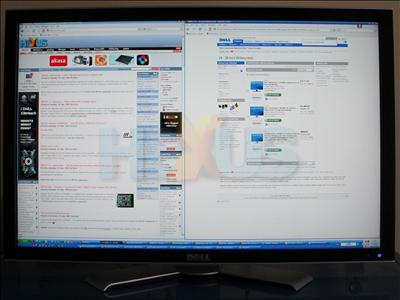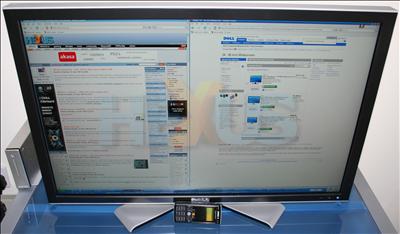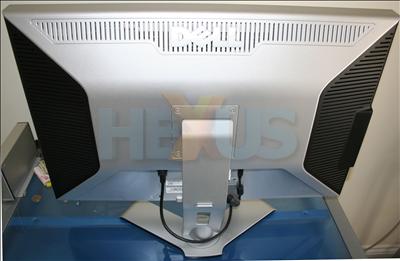Visual look and thoughts
Dell ships the monitor in a box large enough to provide adequate covering should your better-half find out just how much money you've spent on your new toy and banish you to the garden shed for a night or two. The box also contains brief instructions, a dual-link DVI cable, and basic monitor software.
In terms of appearance, the 3007WFP-HC is visually identical to the model it replaces. A small plate on the back is the only outward indication that you're in possession of a higher-spec model.
Image quality
Switching it on directly after unplugging my venerable 3007 non-HC monitor, the first thought that came across my mind was that there's something utterly wrong with the HC's picture. Compared to the washed-out look of the basic WFP, the HC's colours appear way too vibrant, too rich, and my eyes reeled back from the visual assault that was akin to be slapped in the face with a wet fish.
Frantically searching for the tuning options - and soon remembering that the display only features brightness controls and no on-screen display - the initial shock of the HC's all-too-vibrant picture passed over the following days, through a combination of my eyes becoming accustomed to the colour and the monitor, seemingly, settling down just as a pair of decent hi-fi speakers do after a week or so of running-in.
Deep reds really are deep and greens - especially the icon for the FTP program I use, CoffeeCup Direct FTP - appear to have a luminous tinge, such is the contrast. The HC model makes my much-praised 2405FPW appear somewhat dark and sombre in comparison. Readers who have seen the difference between LED-backlit and standard CCFL LCDs will appreciate just what I'm referring to.
I was somewhat sceptical of just how much better the image quality would be with an increase in the colour gamut. The difference in quality is great enough for the non-HC model to be banished from my desk forever. Interestingly, the HC's lower-rated brightness doesn't impact upon actual performance, as far as I could observe.
5 months in and the 3007WFP-HC hasn't missed a beat, despite being used 60 hours a week, every week. The WCCFL backlight is even across the entire screen and text is razor-sharp in the very corners.
High-resolution gaming is fun, especially as the latest iteration of GPUs from NVIDIA and AMD - G80 and R600, respectively - can drive a number of first-person shooters at reasonable framerates at the panel's native WQXGA resolution. There's no obvious tearing and the richer colours offer a more immersive experience. Video-playback, too, is decent. I'd like to say that the HC easily outperformed the regular 30in WFP in both gaming and video-playback but, honestly, I couldn't tell the difference, other than the aforementioned richer colours. So far, so good, then.
Adjustments and connectivity
Like its predecessor, the HC features 90mm of vertical-height adjustment, 120 degrees of swivel, and a total of 22 degrees of tilt. You cannot, however, place the monitor in portrait mode; it's simply too large for that.
There are no built-in speakers in the 3007WFP-HC so you will need to invest in an optional sound-bar, mounted in between the bezel and stand, if you wish to take advantage of LCD-based sound. Most users, including myself, rely on external sound through discrete speakers.
The power circuitry is built into the panel itself, meaningt that power is fed through a regular kettle-type cable from your mains supply. The panel becomes warmest at the very top, right along the Dell sign, and the ventilation is necessary rather than mere decoration.
Dell quotes a maximum pull of 177W from the 30in panel. Using the trusty watt-meter and leaving the brightness to just above the midrange setting, I observed an average pull of 110W over a 30-minute period. To put that in some kind of perspective, running it 40 hours a week will cost you around £22 ($45) per year.
The chassis is the same so it features a 9-in-2 multicard reader that hooks up to your PC via a downstream USB connection.
2 of the 4 USB2.0 ports are shown alongside the downstream port. The lack of external connectivity is manifested in the sole provision of a single dual-link DVI input, necessary to drive the 2560x1600 resolution.
The £900 'HC is backed up by a 3-year next business day warranty as standard, which is good.
















